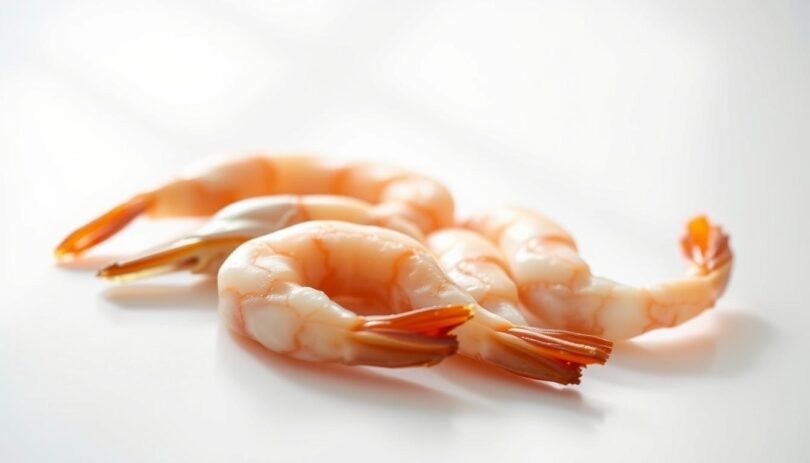Every pet owner knows the joy of sharing a snack with their furry companion. But when those pleading eyes beg for a bite of your seafood dinner, questions arise. Are shellfish treats safe? What about the crunchy tails left on the plate?
This article explores how to safely incorporate crustaceans into a pet’s diet. While properly prepared shellfish can offer lean protein and antioxidants, tails and shells present unique risks. Choking hazards and bacterial contamination top the list of concerns veterinarians emphasize.
Reputable organizations like the AKC and PetMD confirm that cooked, deveined shrimp—without additives—can be an occasional treat. However, preparation matters. Boiling or steaming removes harmful pathogens, while portion control prevents digestive upset.
Throughout this guide, you’ll discover:
- Nutritional benefits of responsibly sourced seafood
- Step-by-step cooking methods to eliminate risks
- Signs of allergic reactions to monitor
By balancing scientific research with practical advice, we aim to help you make informed decisions. Let’s dive into the details of keeping tails off the menu while safely sharing this oceanic protein.
Why Consider Shrimp as a Dog Treat?
Pet owners often seek nutrient-packed snacks to complement their companion’s meals. Shrimp stands out as a low-calorie option packed with lean protein and essential nutrients. When prepared thoughtfully, these crustaceans can add variety to a pet’s diet while supporting overall wellness.
Nutritional Benefits of Shrimp for Dogs
A 3-ounce serving provides nearly 20 grams of protein, aiding muscle maintenance. It’s also rich in vitamin B12 for nerve health and antioxidants like astaxanthin, which fights inflammation. Unlike many processed treats, shrimp contains no artificial additives when cooked plainly.
Key Considerations for Including Shrimp in a Dog’s Diet
Raw shellfish carry harmful bacteria, so boiling or steaming is crucial. Remove all shells to prevent intestinal blockages, and avoid seasoning. While shrimp offers benefits, it shouldn’t replace balanced dog food due to its high sodium content.
Small portions work best—think of shrimp as an occasional reward. Always monitor pets for allergic reactions, such as itching or digestive discomfort. Pairing this seafood with regular meals ensures pets enjoy its perks without nutritional imbalances.
Preparing Shrimp for Dogs: Safety First
Transforming shrimp into a safe snack requires careful steps. Proper handling preserves nutritional value while eliminating risks. Follow these veterinarian-approved methods to ensure every bite supports your companion’s well-being.
Proper Cooking Methods to Eliminate Bacteria
Always cook crustaceans thoroughly. Boiling or steaming for 3-4 minutes kills harmful pathogens like salmonella. Avoid oils, butter, or seasonings—plain preparation protects your pup’s digestive health.
Overcooking reduces nutrients, so time it carefully. Let shrimp cool completely before serving. This prevents mouth burns and maintains texture your pet can manage.
Peeling, Deveining, and Removing Choking Hazards
Start by removing the shell and tail. These rigid parts can splinter or block airways. Use a paring knife to slice along the back and extract the dark digestive vein.
Chop cooked shrimp into pea-sized pieces for smaller breeds. This minimizes choking risks while allowing easy nutrient absorption. Discard all scraps immediately to prevent counter-surfing accidents.
Stick to minimal portions—one or two bites weekly for most pets. Pairing this protein with regular meals maximizes health benefits without disrupting dietary balance.
Can Dogs Eat Shrimp Tails?
When sharing seafood with pets, safety should always come first. While properly prepared shellfish meat offers nutritional value, tails remain a hidden danger. Veterinary studies consistently highlight their risks, making removal non-negotiable.
Understanding the Risks of Shrimp Tails: Choking and Digestive Issues
Shrimp tails pose two primary threats. Their sharp, rigid structure can lodge in throats or puncture soft tissues. Even if swallowed, these fragments may scrape intestinal linings or form blockages requiring surgery.
Animal nutritionists warn against feeding shrimp tails due to high chitin content. This fibrous material resists digestion, potentially causing vomiting or constipation. A 2022 study published in the Journal of Veterinary Science linked shellfish shell ingestion to 18% of seafood-related pet emergencies.
Raw preparations amplify these dangers. Uncooked tails harbor harmful bacteria like listeria, which thrive in canine digestive systems. Always cook and peel crustaceans thoroughly before sharing.
Key safety practices include:
- Discarding tails immediately after peeling
- Checking for shell fragments in prepared foods
- Consulting a vet if accidental ingestion occurs
Pet owners should treat tails like chicken bones—risky despite small sizes. Opt for pre-peeled varieties when incorporating seafood into homemade meals. Vigilance ensures pets enjoy novel foods without compromising their well-being.
Health Risks and Allergic Reactions in Dogs
Introducing new foods to pets always carries potential risks. Shellfish allergies affect roughly 1 in 7 dogs, according to veterinary nutrition studies. While properly prepared cooked shrimp offers nutritional benefits, reactions can range from mild itching to life-threatening emergencies.
Identifying Symptoms of Shrimp Allergies
Watch for itching, hives, or facial swelling within hours of consumption. Gastrointestinal signs like vomiting or diarrhea often appear first. Unlike chicken or beef allergies, shrimp-related reactions may involve sudden lethargy or difficulty breathing.
Even shrimp-safe preparation methods can’t eliminate all risks. Residual proteins in cooked shrimp might trigger sensitivities. Always start with tiny portions and monitor pets for 24 hours.
When to Consult Your Veterinarian
Seek immediate care if your pet shows throat swelling, rapid heartbeat, or collapse. For mild symptoms like paw-licking or loose stools, contact your vet within 24 hours. Bring packaging details if shrimp shells or seasoning were accidentally ingested.
Prevent issues by avoiding raw preparations and double-checking for shell fragments. Store seafood securely to prevent counter surfing. Pair these precautions with regular health checks to ensure long-term safety.
Moderation and Portion Control for Canine Diets
Balancing nutrition and treats requires precision. For pets, even healthy snacks like seafood demand careful measurement. Overfeeding can lead to sodium spikes or digestive strain, especially in sensitive animals.
Guidelines for Different Sizes and Health Needs
Small breeds under 20 pounds should receive 1-2 bite-sized pieces weekly. Medium dogs (20-50 lbs) can handle 3-4 pieces, while large breeds may tolerate ½ cup of chopped meat monthly. Always adjust for existing conditions—pets with kidney issues or dogs allergic to seafood need stricter limits.
Veterinary nutritionists recommend treats never exceed 10% of daily calories. A 2023 study found 15% of diet-related vet visits stemmed from portion mismanagement. Symptoms like vomiting or lethargy often signal overconsumption.
Key practices include:
- Chopping shrimp into pea-sized pieces to prevent choking
- Scheduling treats between meals to avoid disrupting the dog diet
- Tracking reactions for 24 hours, especially in dogs allergic to shellfish
Pair these portions with regular checkups. If introducing seafood, start with one piece and monitor for itching or stomach upset. Responsible moderation keeps tails wagging safely.
Tips for Safely Feeding Shrimp to Dogs
Transforming crustaceans into pet-friendly snacks requires precision. While these oceanic morsels offer valuable nutrients, every step from preparation to serving impacts safety. Follow these practical strategies to minimize hazards while preserving nutritional benefits.
Steps to Eliminate Dangerous Ingredients
Begin by removing all shells and tails before cooking. These rigid parts pose choking risks and may damage digestive tissues. Use a sharp knife to devein each piece, eliminating potential bacterial contamination.
Cook plain shrimp in boiling water for 3 minutes—no oils, garlic, or salt. This method retains nutrients while killing harmful pathogens. Cool thoroughly and chop into bite-sized portions matching your pet’s size.
Serving Shrimp as an Occasional Healthy Treat
Limit portions to 1-2 pieces weekly for small companions. Larger pets can handle slightly more, but never exceed 10% of their daily calories. Pair this protein with regular meals to maintain dietary balance.
Always inspect each piece for shell fragments before serving. Store leftovers in sealed containers, and discard uneaten portions after 48 hours. This approach ensures pets enjoy novel flavors without compromising their well-being.
Shrimp in a Balanced Diet: Integrating Seafood Wisely
A diverse diet plays a crucial role in maintaining canine vitality. While lean proteins like chicken dominate many pet food formulas, seafood offers unique benefits dogs can’t get from land-based meats. Thoughtful integration creates nutritional harmony.
Protein Showdown: Ocean vs. Land
Shrimp provides 20% more omega-3 fatty acids per ounce than turkey, supporting skin and coat health. Unlike beef, it’s naturally low in saturated fats. However, poultry and red meats deliver higher levels of iron and zinc—minerals essential for immune function.
Seafood’s strength lies in its anti-inflammatory properties. The fatty acids in shrimp combat joint stiffness, while B vitamins boost energy metabolism. For pets with food sensitivities, it serves as a novel protein source that may reduce allergic reactions.
Veterinary nutritionists recommend these guidelines:
- Limit seafood to 10% of weekly protein intake
- Rotate shrimp with salmon or whitefish for varied benefits
- Always balance with fiber-rich vegetables and whole grains
While feeding shrimp dog owners should consider portion frequency. Offering this treat once weekly maintains novelty without displacing staple nutrients. Pairing small portions with regular meals answers common concerns about dietary gaps.
Remember: Even the best protein sources require moderation. Shrimp tails and shells remain off-limits, but properly prepared meat adds valuable variety. A strategic mix of land and sea proteins creates meals that support lifelong wellness.
Final Thoughts on Shrimp for Dogs
Offering seafood as an occasional treat requires balancing nutritional perks with safety precautions. Properly prepared shellfish provide lean protein and essential vitamins when handled thoughtfully. However, tails and shells demand careful removal to prevent choking hazards or digestive complications.
Thorough cooking eliminates harmful bacteria while preserving its high protein content. Always serve plain, deveined pieces in tiny portions matched to your companion’s size. Monitoring for reactions ensures individual tolerance aligns with this novel protein source.
When introducing new foods, consulting a trusted veterinarian helps address specific health concerns. Stick to recommended serving frequencies—overindulgence risks sodium spikes or nutrient imbalances despite its high nutritional value.
By prioritizing preparation guidelines and portion control, pet owners can confidently explore dietary variety. Thoughtful choices keep tails wagging safely while enjoying oceanic flavors responsibly.
FAQ
Are shrimp tails safe for pets to consume?
No. Shrimp tails pose choking risks and may cause intestinal blockages or irritation. Always remove tails, shells, and sharp fragments before offering shrimp to pets.
What nutrients in shrimp support animal health?
Shrimp provide lean protein, omega-3 fatty acids, and antioxidants like astaxanthin. These nutrients promote joint health, skin vitality, and immune function when served in moderation.
How should owners prepare shrimp to minimize risks?
Cook shrimp thoroughly (boiled or steamed without seasoning), remove shells and veins, and chop into bite-sized pieces. Avoid butter, garlic, or salt, which are harmful to pets.










Leave a Comment